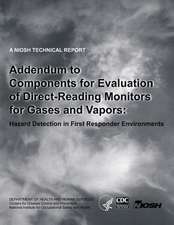Designing for Situation Awareness: An Approach to User-Centered Design, Second Edition
Autor Mica R. Endsleyen Limba Engleză Paperback – 19 dec 2011
Addressing the information gap between the plethora of disorganized, low-level data and what decision makers really need to know, Designing for Situation Awareness: An Approach to User-Centered Design, Second Edition provides a successful, systematic methodology and 50 design principles for engineers and designers seeking to improve the situation awareness of their systems' users based on leading research on a wide range of relevant issues.
See what’s new in the Second Edition:
- Significantly expanded and updated examples throughout to a wider range of domains New Chapters: Situation Awareness Oriented Training and Supporting SA in Unmanned and Remotely Operated Vehicles
- Updated research findings and expanded discussion of the SA design principles and guidelines to cover new areas of development
Preț: 564.94 lei
Preț vechi: 614.07 lei
-8% Nou
Puncte Express: 847
Preț estimativ în valută:
108.11€ • 117.40$ • 90.82£
108.11€ • 117.40$ • 90.82£
Carte disponibilă
Livrare economică 01-15 aprilie
Livrare express 15-21 martie pentru 34.87 lei
Preluare comenzi: 021 569.72.76
Specificații
ISBN-13: 9781420063554
ISBN-10: 1420063553
Pagini: 396
Ilustrații: 146 black & white illustrations, 16 colour illustrations, 17 black & white tables
Dimensiuni: 156 x 234 x 18 mm
Greutate: 0.57 kg
Ediția:Revizuită
Editura: CRC Press
Colecția CRC Press
ISBN-10: 1420063553
Pagini: 396
Ilustrații: 146 black & white illustrations, 16 colour illustrations, 17 black & white tables
Dimensiuni: 156 x 234 x 18 mm
Greutate: 0.57 kg
Ediția:Revizuită
Editura: CRC Press
Colecția CRC Press
Public țintă
Academic and Professional Practice & DevelopmentCuprins
Understanding Situation Awareness in System Design. User-Centered Design. What is Situation Awareness. SA Demons: The Enemies of Situation Awareness. The Design Process. Creating Situation Awareness-Oriented Designs. Determining SA Requirements. Principles of Designing for SA. Confidence and Uncertainty in SA and Decision Making. Dealing with Complexity. Alarms, Diagnosis, and SA. Automation and Situation Awareness. Designing to Support SA for Multiple and Distributed Operators. Multi-modal and 3-D displays. Supporting SA in Remote Control Operations. Completing the Design Cycle. Evaluating Design Concepts for SA. Applying SA-Oriented Design to Complex Systems. Appendix A: Goal-directed Task Analysis for Commercial Airline Pilots.
Descriere
Liberally illustrated with actual design examples, this book demonstrates how people acquire and interpret information and examines the factors that undermine this process. The first edition successfully filled a significant gap in the market, presenting a core set of principles and a methodology for engineers and designers who are seeking to nourish the situation awareness of their systems' users. The second edition significantly expands and updates the examples throughout to include a wider range of domains and increases the coverage of SA design principles and guidelines to include new areas of current development. It translates current research into a usable, applicable method and guidelines.





















